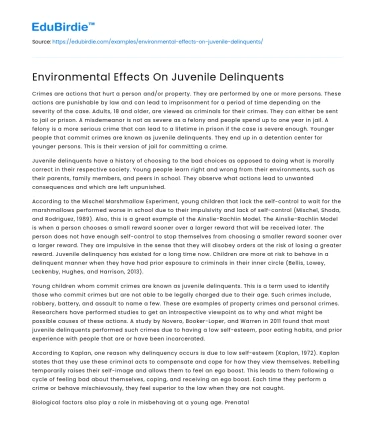Crimes are actions that hurt a person and/or property. They are performed by one or more persons. These actions are punishable by law and can lead to imprisonment for a period of time depending on the severity of the case. Adults, 18 and older, are viewed as criminals for their crimes. They can either be sent to jail or prison. A misdemeanor is not as severe as a felony and people spend up to one year in jail. A felony is a more serious crime that can lead to a lifetime in prison if the case is severe enough. Younger people that commit crimes are known as juvenile delinquents. They end up in a detention center for younger persons. This is their version of jail for committing a crime.
Juvenile delinquents have a history of choosing to the bad choices as opposed to doing what is morally correct in their respective society. Young people learn right and wrong from their environments, such as their parents, family members, and peers in school. They observe what actions lead to unwanted consequences and which are left unpunished.
Save your time!
We can take care of your essay
- Proper editing and formatting
- Free revision, title page, and bibliography
- Flexible prices and money-back guarantee
According to the Mischel Marshmallow Experiment, young children that lack the self-control to wait for the marshmallows performed worse in school due to their impulsivity and lack of self-control (Mischel, Shoda, and Rodriguez, 1989). Also, this is a great example of the Ainslie-Rachlin Model. The Ainslie-Rachlin Model is when a person chooses a small reward sooner over a larger reward that will be received later. The person does not have enough self-control to stop themselves from choosing a smaller reward sooner over a larger reward. They are impulsive in the sense that they will disobey orders at the risk of losing a greater reward. Juvenile delinquency has existed for a long time now. Children are more at risk to behave in a delinquent manner when they have had prior exposure to criminals in their inner circle (Bellis, Lowey, Leckenby, Hughes, and Harrison, 2013).
Young children whom commit crimes are known as juvenile delinquents. This is a term used to identify those who commit crimes but are not able to be legally charged due to their age. Such crimes include, robbery, battery, and assault to name a few. These are examples of property crimes and personal crimes. Researchers have performed studies to get an introspective viewpoint as to why and what might be possible causes of these actions. A study by Novero, Booker-Loper, and Warren in 2011 found that most juvenile delinquents performed such crimes due to having a low self-esteem, poor eating habits, and prior experience with people that are or have been incarcerated.
According to Kaplan, one reason why delinquency occurs is due to low self-esteem (Kaplan, 1972). Kaplan states that they use these criminal acts to compensate and cope for how they view themselves. Rebelling temporarily raises their self-image and allows them to feel an ego boost. This leads to them following a cycle of feeling bad about themselves, coping, and receiving an ego boost. Each time they perform a crime or behave mischievously, they feel superior to the law when they are not caught.
Biological factors also play a role in misbehaving at a young age. Prenatal and birth complications as well as the rejection of their mother within the few months have shown to increase the likelihood of a child growing up to be more aggressive (Raine, Meloy, Bihrle, Stoddard, LaCasse, and Buchsbaum, 1988). Raine also noted that low levels of cortisol in young children is a possible indicator of aggression later on in life (Glenn & Raine, 2014). According to Raine and Glenn, any disruptions to the hypothalamus, pituitary, and adrenal glands will cause a hormonal imbalance which leads to antisocial behavior.
Being exposed to criminal activity teaches the children that the behavior is what they should strive to achieve. They are being taught to make the wrong decisions at a young age. Children in low social economic status areas are more at risk to becoming juvenile delinquents because they lack the appropriate resources to achieve something greater.
The combination of children’s self-image, biological factors, and environmental factors play a key role in their development. Most children are not fortunate enough to have positive mentors in their lives. Therefore they fall into a vicious cycle of committing crimes. Breaking the cycle is more difficult when their only role models are their parents that have been placed in jail or prison and are absent from their lives.
Parental incarcerations affects approximately 1 in every 25 children (Sykes & Pettit, 2014). In an average school, each class holds about 25 children, this means at least one child in each class has a parent that is or has been to jail or prison. This negatively impacts them in their school setting because they are perceived as the bad children in the class. Most mimic the behavior they are exposed to at home. This varies amongst social class and race but the outcomes is almost always the same. The family is left as a single parent household. The singular parent does what they can do maintain the structure of the family together and at times fails to provide enough attention to their child(ren).






 Stuck on your essay?
Stuck on your essay?

